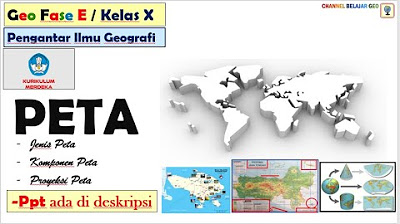Geografia - Aula 01 - Orientação e Cartografia
Summary
TLDRIn this educational video, Professor Jordano introduces key geographical concepts such as spatial orientation, map scales, and cartographic projections. He begins by explaining the importance of the compass rose and points of direction, including the distinction between cardinal, intercardinal, and alternative terms. The lesson covers latitude and longitude, their applications in climate zones and time zones, and the key differences between large and small-scale maps. Additionally, the video explores various map projections, including Mercator's Eurocentric approach and Peters' focus on size accuracy. The video concludes with practical examples of scale calculations and projections, aiming to enhance students' geographical understanding.
Takeaways
- 😀 The cardinal directions (north, south, east, west) are fundamental for spatial orientation, and understanding them is essential for navigation and geography.
- 😀 The cardinal directions have additional names: 'meridional' or 'austral' for south, 'setentrional' or 'boreal' for north, 'oriente' for east, and 'ocidente' for west.
- 😀 The movement of the sun is apparent due to Earth's rotation and revolution, not the sun itself moving.
- 😀 Latitude and longitude are essential for pinpointing locations on Earth, with latitude defining the climate zones and longitude determining time zones.
- 😀 Latitude ranges from 0 to 90 degrees, and longitude ranges from 0 to 180 degrees, with positive and negative values used to denote their respective hemispheres.
- 😀 The Earth is divided into four quadrants based on latitude and longitude, with Brazil predominantly located in the southwestern quadrant.
- 😀 The equator and the prime meridian (Greenwich Meridian) are critical reference points in global geography, marking the boundaries of the northern and southern hemispheres and the western and eastern hemispheres.
- 😀 Scale in maps is a relationship between distance on the map and the actual distance on Earth, with larger areas requiring more reduction and providing fewer details.
- 😀 A smaller numerical scale indicates a larger map area, while a larger scale provides more detail but covers a smaller area.
- 😀 When working with scale, converting real distances (e.g., kilometers) into map distances (e.g., centimeters) requires careful unit conversion to ensure accurate results.
- 😀 Different map projections are used to depict the world, with cylindrical projections (Mercator) distorting polar regions and conic projections being ideal for mid-latitudes. The Peters projection focuses on showing the true sizes of continents.
Q & A
What is the main purpose of the 'rose of the winds' as explained in the script?
-The 'rose of the winds' serves as a basic orientation tool, allowing one to identify cardinal directions (north, south, east, west) and intercardinal directions (northeast, southwest, etc.), which are essential for geographic understanding.
How are the cardinal directions referred to in different terms in the script?
-The cardinal directions are referred to as follows: 'south' can be called 'meridional' or 'austral', 'north' can be 'setentrional' or 'boreal', 'east' can be 'oriental' or 'nascente', and 'west' can be 'occidental' or 'poente'.
What important fact about the movement of the sun does the script emphasize?
-The script emphasizes that the sun does not actually move; it is the Earth that rotates and orbits around the sun, creating the apparent movement of the sun in the sky.
What are the key components of geographic coordinates as explained in the script?
-Geographic coordinates consist of latitude and longitude. Latitude ranges from 0° to 90° (north or south), while longitude ranges from 0° to 180° (east or west). Together, these form the geographic coordinate system.
How is the Earth's surface divided in terms of hemispheres and quadrants?
-The Earth is divided into four quadrants based on latitude and longitude: the northern and southern hemispheres are separated by the Equator, while the eastern and western hemispheres are divided by the Prime Meridian.
What is the significance of the Equator and Prime Meridian in the geographic coordinate system?
-The Equator (0° latitude) separates the northern and southern hemispheres, while the Prime Meridian (0° longitude) divides the eastern and western hemispheres, forming the basis for global geographic coordinates.
What is the difference between a large-scale and small-scale map in terms of detail and area covered?
-A large-scale map covers a smaller area but provides more detailed information, while a small-scale map covers a larger area with less detail. The scale number reflects how many times the real-world area has been reduced.
What formula is used to calculate distances using a map scale?
-The formula used is: Distance on the map (graphic distance) = Distance in reality (real distance) × Scale. The scale is represented as a ratio, such as 1:500,000, and distances are usually converted to match the units used in the scale.
How does the script explain the conversion between kilometers and centimeters in map calculations?
-To convert from kilometers to centimeters, you multiply by 100,000 (since there are 100,000 centimeters in a kilometer). For the reverse conversion from centimeters to kilometers, you divide by 100,000.
What are the three main types of map projections mentioned in the script?
-The script mentions three types of map projections: cylindrical (e.g., Mercator projection), conical, and azimuthal (or planar). Each projection serves a different purpose, with cylindrical projections ideal for navigation, conical for mid-latitudes, and azimuthal for polar regions.
Outlines

Этот раздел доступен только подписчикам платных тарифов. Пожалуйста, перейдите на платный тариф для доступа.
Перейти на платный тарифMindmap

Этот раздел доступен только подписчикам платных тарифов. Пожалуйста, перейдите на платный тариф для доступа.
Перейти на платный тарифKeywords

Этот раздел доступен только подписчикам платных тарифов. Пожалуйста, перейдите на платный тариф для доступа.
Перейти на платный тарифHighlights

Этот раздел доступен только подписчикам платных тарифов. Пожалуйста, перейдите на платный тариф для доступа.
Перейти на платный тарифTranscripts

Этот раздел доступен только подписчикам платных тарифов. Пожалуйста, перейдите на платный тариф для доступа.
Перейти на платный тариф5.0 / 5 (0 votes)






